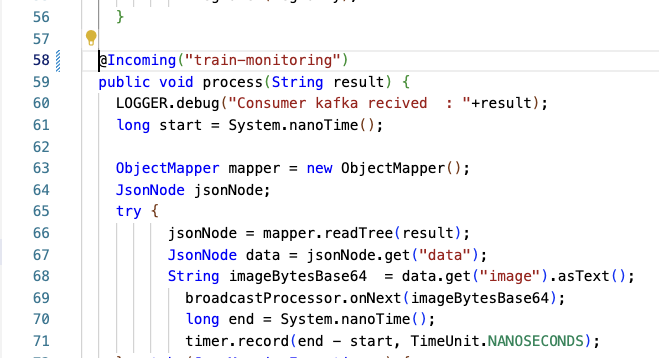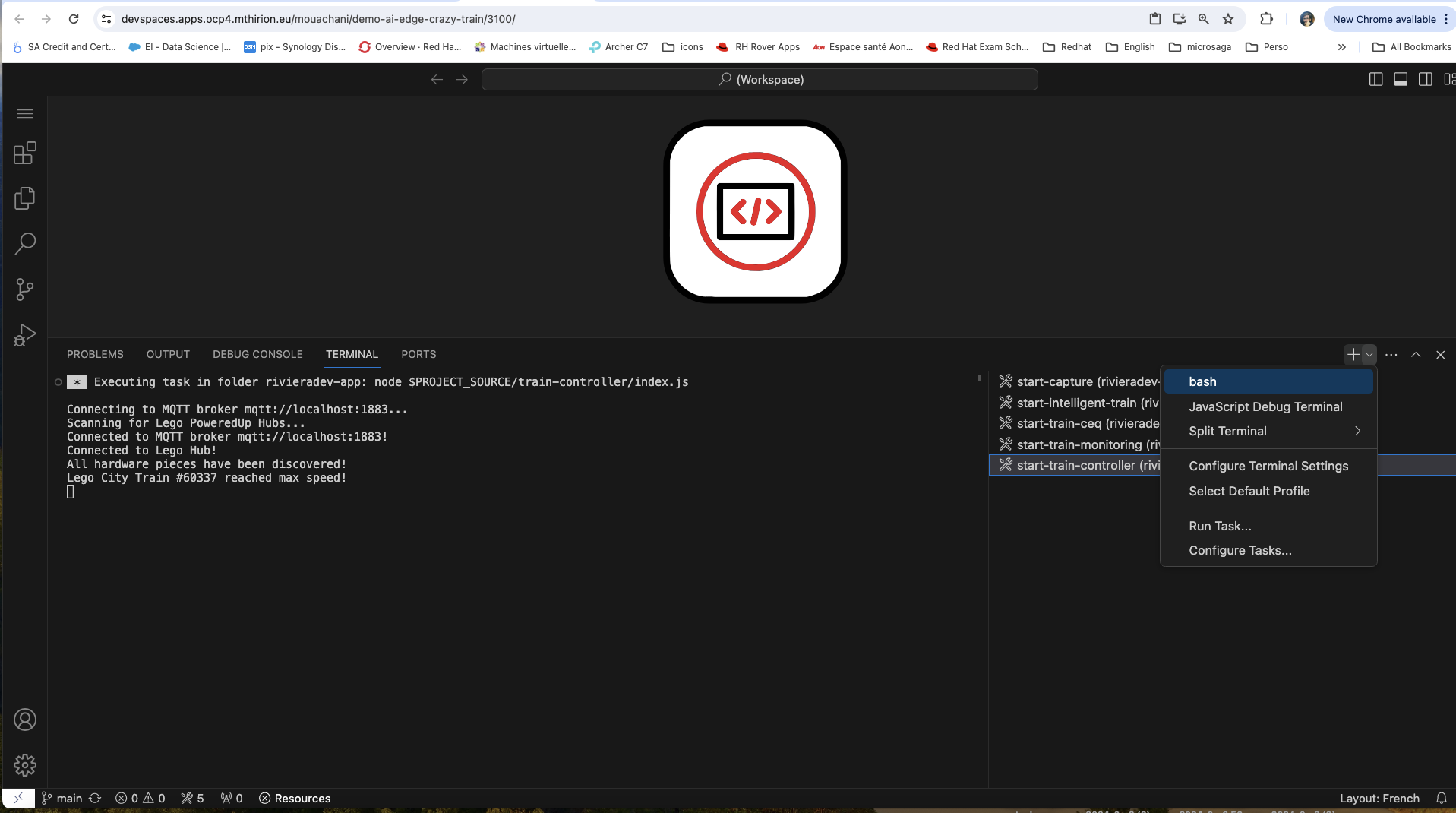Monitoring
The monitoring-app is an application which monitors the status and behaviour of the train and its associated components. This microservice is responsible for :
-
Data collection: The monitoring-appp application collects data from a kafka topic. This includes events produced by train-ceq-app.
-
Data analysis: Once the data has been collected, the monitoring-appp application adds the predictions calculated above to the original image.
-
Data visualisation: The monitoring-appp application provides a user interface for viewing train data in real time.
In the monitoring-app project, you will modify certain properties and the code with the following instructions:
- Modify the configuration file: Open the configuration file for your application. This is the file named
src/main/resources/application.properties. Add the following properties:
mp.messaging.incoming.train-monitoring.connector=smallrye-kafka
mp.messaging.incoming.train-monitoring.topic=${KAFKA_TOPIC_MONITORING_NAME:train-monitoring}
mp.messaging.incoming.train-monitoring.cloud-events=false
mp.messaging.incoming.train-monitoring.value.deserializer=org.apache.kafka.common.serialization.StringDeserializer
These properties configure the application to use the SmallRye Kafka connector to read messages from the Kafka train-monitoring topic. The deserializer is configured to convert the Kafka messages, which are bytes, into character strings.
- Modify the ImageProcessing class: Open the file
src/main/java/org/redhat/demo/crazytrain/processing/ImageProcessing.java.
Add the @Incoming("train-monitoring") annotation to the process method. Below is the result:

The @Incoming annotation indicates that this method should be called whenever a message is read from the train-monitoring channel. The message is passed to the method as a parameter.
These modifications allow our application to consume messages from the Kafka train-monitoring topic and process them with the process method of the ImageProcessing class.
- Checking the code
The src/main/java/org/redhat/demo/crazytrain/processing/ImageProcessing.java class should look like this:
package org.redhat.demo.crazytrain.processing;
import java.util.Base64;
import java.util.concurrent.TimeUnit;
import org.eclipse.microprofile.reactive.messaging.Incoming;
import jakarta.ws.rs.core.MediaType;
import jakarta.ws.rs.GET;
import jakarta.ws.rs.Path;
import jakarta.ws.rs.Produces;
import jakarta.annotation.PostConstruct;
import jakarta.inject.Inject;
import org.eclipse.microprofile.config.inject.ConfigProperty;
import org.jboss.logging.Logger;
import org.opencv.core.CvType;
import org.opencv.core.Mat;
import org.redhat.demo.crazytrain.services.SaveService;
import com.fasterxml.jackson.core.JsonProcessingException;
import com.fasterxml.jackson.databind.JsonMappingException;
import com.fasterxml.jackson.databind.JsonNode;
import com.fasterxml.jackson.databind.ObjectMapper;
import io.micrometer.core.instrument.MeterRegistry;
import io.micrometer.core.instrument.Timer;
import io.smallrye.mutiny.Multi;
import io.smallrye.mutiny.operators.multi.processors.BroadcastProcessor;
@Path("/train-monitoring")
public class ImageProcessing {
private static final Logger LOGGER = Logger.getLogger(ImageProcessing.class);
private final BroadcastProcessor<String> broadcastProcessor = BroadcastProcessor.create();
@Inject
SaveService saveService;
@ConfigProperty(name = "monitoring.saveImage")
boolean saveImage;
@ConfigProperty(name = "monitoring.tmpFolder")
String tmpFolder;
@Inject
MeterRegistry registry;
Timer timer;
@PostConstruct
void init() {
timer = Timer.builder("image.processing.time")
.description("Time taken to get a message from Kafka and process it")
.register(registry);
}
@Incoming("train-monitoring")
public void process(String result) {
LOGGER.debug("Consumer kafka recived : "+result);
long start = System.nanoTime();
ObjectMapper mapper = new ObjectMapper();
JsonNode jsonNode;
try {
jsonNode = mapper.readTree(result);
JsonNode data = jsonNode.get("data");
String imageBytesBase64 = data.get("image").asText();
broadcastProcessor.onNext(imageBytesBase64);
long end = System.nanoTime();
timer.record(end - start, TimeUnit.NANOSECONDS);
} catch (JsonMappingException e) {
// TODO Auto-generated catch block
e.printStackTrace();
} catch (JsonProcessingException e) {
// TODO Auto-generated catch block
e.printStackTrace();
}
}
@GET
@Produces(MediaType.SERVER_SENT_EVENTS)
public Multi<String> stream() {
return broadcastProcessor.toHotStream();
}
}
The application.properties file should look like :
%dev.quarkus.http.port=8086
# Configure the Kafka source
kafka.bootstrap.servers=${KAFKA_BOOTSTRAP_SERVERS:localhost:9092}
mp.messaging.incoming.train-monitoring.connector=smallrye-kafka
mp.messaging.incoming.train-monitoring.topic=${KAFKA_TOPIC_MONITORING_NAME:train-monitoring}
mp.messaging.incoming.train-monitoring.cloud-events=false
mp.messaging.incoming.train-monitoring.value.deserializer=org.apache.kafka.common.serialization.StringDeserializer
mp.messaging.outgoing.commands-out.connector=smallrye-kafka
mp.messaging.outgoing.commands-out.topic=${KAFKA_TOPIC_COMMAND_CAPTURE_NAME:train-command-capture}
mp.messaging.outgoing.commands-out.value.serializer=org.apache.kafka.common.serialization.StringSerializer
monitoring.saveImage=${SAVE_IMAGE:false}
monitoring.tmpFolder=${TMP_FOLDER:/tmp/crazy-train-images}
quarkus.log.level=${LOGGER_LEVEL:INFO}
quarkus.swagger-ui.always-include=true
%dev.kafka.topic.train-command-capture.replication.factor=1
%dev.kafka.topic.train-monitoring.replication.factor=1
- Compiling the project
Before committing your changes, you need to build the project to ensure that there are no compilation errors.
- Open a new terminal

- Run the commands below
cd monitoring-app
mvn clean package
Check that there are no errors then close the terminal.